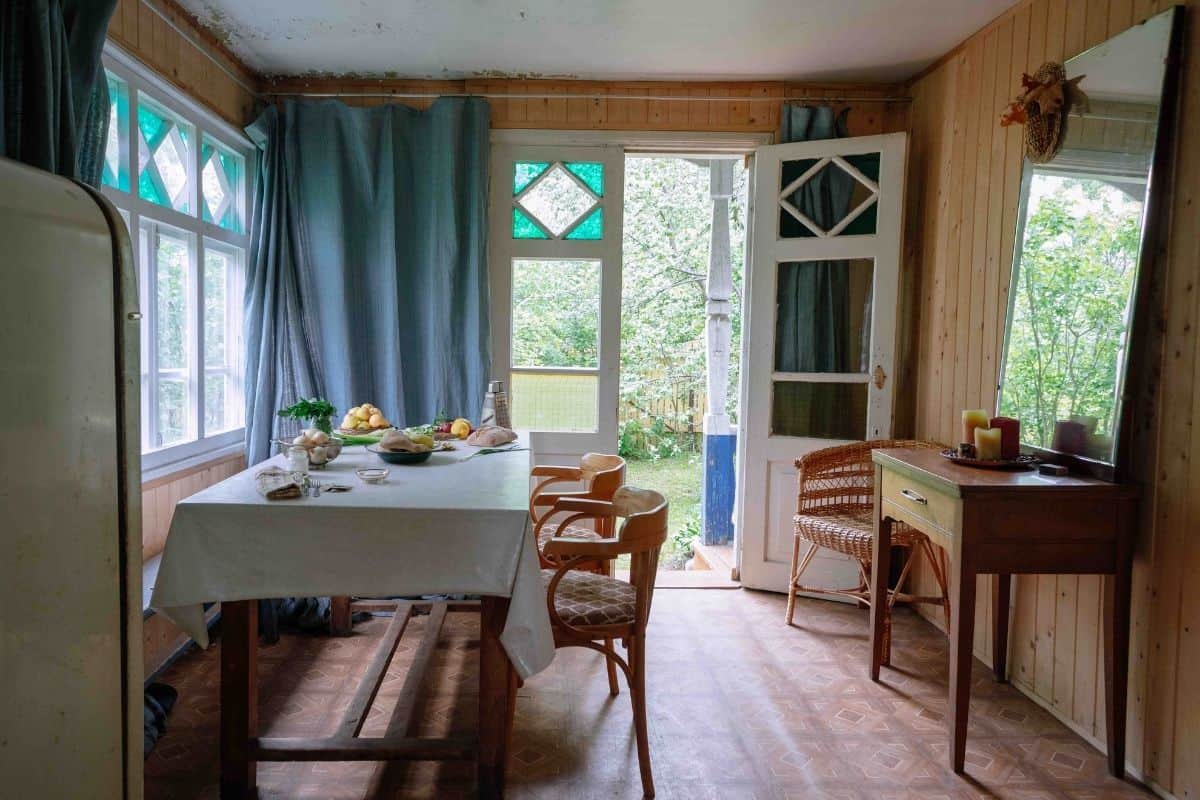The Best Simple Living Tips: An Essential Guide for Beginners
So many people in the modern world are feeling stressed and overwhelmed. The idea of “simple living” can be like a siren call when we feel like we just can’t take it anymore. But what is a simple lifestyle? Can you do it? Why should you? Here’s a closer look at what Simple Living really is, and how you can take small steps toward simplification in your own life.
What is Simple Living?

I decided to go ahead and check out what the dictionary actually says. Yep, we’re going to lean into the cliché and provide the definition of the term.
Merriam-Webster defines “The Simple Life” as: “A manner of living in which a person does not own many things or use many modern machines and usually lives in the countryside.”
This is what most people probably think of when they hear “simple living.” Minimalism and homesteading/self-sufficiency are a big part of the Simple Living Movement.
I think both Minimalism and homesteading are great ways to return to the more simple things. At the same time, I think the concept of Simple Living is much broader.
For example, Minimalism is usually about material possessions – but the overarching concept of Simple Living is more about focus. I think we can take a look at the word “simple” and know right away how we can each move more in that direction. And that will mean something different to everyone.
There will be people for whom pursuing a simple life means buying a small cabin on 20 acres near a small town, becoming totally self-sufficient, raising lots of livestock, and maintaining a large garden.
For some people, that sounds overwhelming and, quite frankly, the exact opposite of simple. For these people, perhaps moving to an apartment or townhome in the city near all the amenities is a way to simplify.
This quote by Joshua Becker of Becoming Minimalist really resonates with me:
“Minimalism is the intentional promotion of the things we most value and the removal of everything that distracts us from it.”
So even minimalism does not refer only to material possessions. Simplifying can go much further. With that in mind, I’ve created this Ultimate Guide to Simple Living to help you find the right path for you.
1. Decide What’s Most Important to you

My first simple living tip is to decide what you want to promote. What do you value most? What is getting in the way? Spend a week or two paying attention to how you spend your time and the things which get most of your energy. Are you satisfied with how things stand?
Make a list of your 4 or 5 highest priorities in life. Take a look at the list and compare it with your observations over the last couple of weeks. Are the most important things getting the majority of your time and energy?
Evaluate your commitments. It’s likely your priorities are not reflected in the way you’re spending most of your time. You may be spending inordinate time on the little things that don’t matter.
If that’s true, take a closer look at your commitments. Can you release anything? Ask yourself this question very seriously. Try to examine your sense of “should” and hold it up against your list of priorities. Does this really need to be in my life?
Learn to say no. This one is SO important. Some of us struggle with saying no because we want to please people. Some of us may feel that if we have the hours in the day to do something, we don’t have a good reason to say no.
It’s important to remember that not only your time but your emotional and mental resources are limited. They need to be spent on your highest priorities!
2. Protect Your Time

Our time is one of our most valuable resources, and once it’s gone it doesn’t come back.
If your new list of priorities is long, you may be feeling like you still don’t have enough time to have the life you want. The next thing to focus on, then, is good habits, efficiency, and productivity.
Simplify tasks. Try to automate tasks wherever possible. If you’re at work, for example, set up email templates for notes you write frequently. At home, group like tasks into single blocks of time so you can get more done.
Delegating tasks to others is another way to free up some time. Give the other family members some chores to do. Sure, they may not be done just the way you want, but it releases some of the mental load and frees up your time. You can also hire help at home if it’s within budget: grocery delivery, diaper service, laundry service, cleaning service…you get the idea.
Create morning and evening routines. When I manage to squeeze out a morning routine at the beginning of the day, it changes everything. When my beautiful, squishy babies come out of their rooms I’m actually happy to see them instead of dreading the barrage of questions and needs.
Days that begin with a morning routine are happier, less stressful, more productive, and more peaceful. An evening routine can help you prepare for the next day – and when you wind down the same way every night, your body knows it’s time to sleep. And your sleep improves!
Plan your time. During your morning routine, give yourself a (flexible!) plan for your priorities for the day.
3. Manage Your Focus

Stop Multi-tasking. This one may seem surprising because multi-tasking seems like such a productive thing to do, right? Not so much actually.
I got myself into such a mess trying to do everything all at once all the time that I started to suffer from chronic anxiety and panic attacks. After a little priority shuffling, I made a significant discovery.
I knew that one of my sources of stress was having a constant awareness and pressure from ALL THE THINGS I needed to do.
It didn’t matter what I was doing at that moment, I was feeling like there was something else I should be doing instead. That made it impossible to be present with my kids or do good work. Everything was suffering.
I heard on a podcast that most people don’t have a time management problem, they have a focus management problem. That rang so true for me, so I decided to try something different. I started time blocking.
In other words, I assigned a block of time (for example, 8am to 11am) for a single task. I carved out time blocks for my biggest priorities, and during those blocks I only worried about that single task.
I became much more efficient and productive. There was less stuff crowding my mental space, and I was also able to enjoy my free time guilt-free. It made a huge difference!
This is more challenging for moms of young children because of constant interruptions. My best advice would be to block time for “interruptable” tasks and don’t let the interruptions stress you out. You can answer questions while you do the dishes and laundry!
Save the tasks that require your full attention for times when the kids aren’t around. (This may be during school, naptime, bedtime, etc.) I have also instituted mandatory quiet time for my oldest, who no longer naps. And, hang in there Mama – this is just a season! It will be over all too soon.
Make a Most Important Tasks list each day. This is a great thing to do during your morning routine. Assign the priorities to specific times to ensure you can get them done. It helps you to stay focused on the things you most want to accomplish that day so you don’t get caught up in the minutia.
4. Protect Your Mental Health
Be present. I know for myself that most of my stress comes from worrying about “what else” instead of focusing on where I am. Give whatever you’re doing your full focus and energy.
Limit screen consumption. This is huge, huge, huge. I can see it in my children when they’re having too much screen time. They get bored more easily, they’re restless, and they think they’re going to die if they can’t watch something RIGHT NOW.
Giving our kids more opportunity to have brain stimulating play and time outdoors is so essential. Even past that, over-consumption of technology can have many adverse affects on physical and mental health – and not just for children.
Learn to Rest. It occurred to me a couple of years ago that I never felt energized after taking a break. After some reflection I concluded that I wasn’t really resting – I was trying to escape. I was shutting down and avoiding my stressors.
When I surfaced I was still facing all the same stressors, and I was no more equipped to handle them than I was before. After my escape time, I had even less time to do what was needed.
Instead of escaping, pay attention to what your body and mind need to refresh. Do you need a quick 10-15 minute cat nap when you get the 4:00 sleepies? Do you need to give your kids a coloring book and tell them you’ll be in your room with the door closed for a couple minutes so you can take a deep breath in the quiet? Sometimes the best way to recharge is simply to take a couple of minutes to breathe.
Learn to do nothing. BE BORED! Ever notice your best ideas come to you in the shower or (forgive me) on the toilet? Because they’re times when we are unplugged and (hopefully!) alone. Giving our brains space without constant external input allows us to think more clearly and be more creative.
I noticed that I have trouble going anywhere without my phone to be able to play a podcast or watch a tv show or just have some music playing. It’s a compulsive need for background noise and distractions. I am very uncomfortable with quiet and boredom – but boredom is good for us!
5. Protect Your Relationships
Spend time with people you love. Be purposeful about setting aside time to connect with your family and friends. I think most of us agree that people are more important than things, but our moment by moment decisions don’t always reflect that value.
When you’re feeling like a victim of the Tyranny of the Urgent, take a moment to reflect on what seems so urgent to you. Sometimes we have little choice – but we often have more choice than we think we do.
The dishes can wait if it means playing a game with the kiddos. Investing in your relationships is both practical and productive.
6. Protect Your Physical Health

Eat healthy and exercise. You may think that adding more things to your to-do list is not a good way to simplify. And I hear you, loud and clear. For a long time that was the way I viewed food and exercise.
And then I developed health problems. I was overweight and had to have back surgery. My diet was not giving me the nutrients and minerals my body needed and I was getting more and more fatigued.
After losing nearly fifty pounds over a span of two years, I am still learning how to make eating healthy fit into my busy life. But, now that I am making a conscious effort to improve my nutritional intake, I have so much more energy and I feel so much more comfortable in my body. It has given me clarity and energy to work on simplifying other areas of my life.
SLEEP. Make sure you get a good night’s sleep. Sleep deprivation has been connected to an increased risk of heart disease, kidney disease, diabetes, and stroke – just to name a few! Making room for enough sleep every night will impact every corner of your life.
7. Live Frugally

Get out of debt. This one is so hard, especially when so many of us feel like we’re drowning in student debt. And I’m not going to lie to you, getting out of debt usually requires enormous sacrifices in comforts and freedoms for a time.
The thing is, debt carries with it an enormous amount of stress. If we’re looking at a stack of credit cards whose bills we can’t pay, then we begin to fear that our our furniture/car/home can be taken away from us.
A life free of debt is one step closer to financial independence. That may be worth fighting hard for.
Simplify expenses. Getting rid of debt also goes a long way toward simplifying your expenses because your number of payments goes down dramatically when you’re debt free. Less money is needed each month, and it may even be possible to drop that extra job if you don’t have so many payments to worry about.
You can also think about what subscriptions you’re paying for that you may not be using very much. Why am I paying for Audible when I haven’t listened to an audiobook in months? Why am I paying for 300 pages/month of printing when I only use 50? Do I really need five different streaming services? Probably not.
Thrifting and Antiquing: This is a great way to find quality pieces of furniture and household items for far less than their sticker price. If you don’t mind something that’s been loved a bit, you can furnish most of your house with second-hand pieces at a small fraction of the cost.
Look at where you shop for groceries. I remember a few years ago feeling determined to cut my grocery bill. I downloaded free shopping PDFs and researched couponing and tried to get super creative about cutting that grocery bill.
Well that fire died pretty quickly and I got tired of doing backflips trying to save a few pennies. So you know what I did? I just switched grocery stores and started doing most of my shopping at Aldi. It literally cut our grocery bill by $400/month when I started shopping there!! I know not everyone has an Aldi nearby, but many times there are lower-priced options for grocery shopping than your traditional grocery store.
Only buy what you need. You’re probably rolling your eyes and thinking, “Well, duh.” But that’s really all it comes down to. If you’re looking to simplify your life, spending less and acquiring less are fantastic ways to do exactly that.
8. Feed Contentment
Don’t worry about what other people’s lives look like. First of all, we all know our propensity for putting our best foot forward on social media. Maybe even sometimes being a little deceptive so others will think well of us.
We MUST remember that this is what almost everyone is doing. When you think that someone else’s life looks so wonderful when yours feels like a dumpster fire, remember. Remember that you don’t see the whole picture – and sometimes you’re not even looking at the truth.
Shut your eyes to everything that’s out there for a moment and examine your own life. First, what is already in your life that you love? Then, what are the needs of your family and how can you meet those needs?
Can you think of the activities or habits that usually result in a feeling of discontent in your own life? The solution is simple: Stop. Think about where you can focus your attention that will help you to be grateful for what you have and aim for what YOU need.
9. Don’t be afraid of Hard Work
This one is a little counterintuitive. Your average person wanting a simple life probably wants a break more than anything. Hard work sounds like the very thing you may be trying to avoid.
But it’s important to remember that simple is not the same as easy. Gardening is hard work. So why garden if you can buy your vegetables at the store? Baking your own bread and cooking your own food is harder than buying bread and ready-made meals from the store. Why do that if you’re trying to simplify?
Now, gardening and baking bread may not be part of the simple life everyone is looking for, but work is inherently good for humans. It contributes to our personal development, and provides a good example for our kids. It contributes value to the world around us.
Don’t be busy just to feel productive. Choose your work carefully. Do your chosen work deliberately and with all of your heart.
10. Simplify Your Wardrobe

Are you one of those people who has so many clothes and always feels like there’s nothing to wear? I’m not a big clothes person myself, but I have historically had more clothes than I needed, and I still feel like I only want to wear about one-third of what’s in my closet.
Get rid of stuff you never want to wear. Start here – even if you only donate an item every couple of days. The next time you find yourself staring at the closet and rejecting the same blouse for the 100th time, put that blouse in the thrift box.
Just like your time should be devoted to the things you love the most – so should your closet. Wear what you love!
Consider a Capsule wardrobe. The basic concept here is to have fewer pieces that combine together to make lots of outfit combinations. If you build your capsule with pieces you absolutely love, you’ll never be stuck not knowing what to wear.
11. Simplify Your Home

As the resident homemaker in my family, one of my biggest sources of stress and overwhelm is my house. Keeping things reasonably tidy is practically a full-time job.
Managing our homes gets more and more difficult the more things we have in our inventory. The fewer items we have, the less we have to manage. Simple, right?
Easy? Not so much.
Declutter. Again, duh, right? I would hazard a guess that clutter is a constant battle in most homes.
If your inventory has grown to unmanageable proportions, take one small bite at a time and keep your expectations realistic. Don’t try to empty the house on one Saturday. Instead, tackle a room at a time. Maybe you need to start with a closet, and that’s ok too!
A place for everything, and everything in its place. This is my life motto. If something doesn’t have a home in my house my first instinct is to throw it out the window. I HATE it when I don’t know where to put something.
If you struggle to find a home for everything, you may still have too many things. Before everything can have a home, you need to have enough homes for all the things!
Go for quality, not quantity. Raise your standards for the items that enter your home. It’s an automatic edit that happens before the clutter even arrives, and that can help enormously.
It’s like your capsule wardrobe – you look around your home and see only things you love. It can contribute to your overall sense of well-being too!
Consider a smaller home. When I got married I lived in a 750 sq. ft. one-bedroom apartment. And it felt hard to fill with furniture because it was the first time I was living on my own. I couldn’t even begin to imagine filling a larger space.
While our space is by no means large now, we have since acquired a grand piano and two additional bedrooms. It was incredible how quickly and effortlessly that space filled with things I didn’t even know or think I needed before. And I arguably don’t even need many of them now.
Another benefit to downsizing is that your energy bills usually get lower. Hello simplifying my home and budget all at once!
12. Simplify Your Eating
There’s this thing called decision fatigue. It’s estimated that the average adult makes 35,000 decisions every day. After making so many, it’s no wonder our brains start to poop out. For me, my decision fatigue around food resulted in a lot of poor decisions made late in the day.
Simplify your nutrition. This is my Step 1. I make sure I have protein, veggies, fruit, healthy fats, and fermented grains every day. I don’t like vegetables, but I chose a few that I do enjoy and didn’t put pressure on myself to have a lot of variety there.
Using my four main food groups, I created a plan for my meals each day and basically gave myself two different variations for breakfast, lunch, and snacks. That way my decisions are super limited – either a veggie omelet or yogurt with fruit and granola for breakfast. Done. I try to make the same things for my family too.
If you don’t get tired of having the same foods all the time, this is a great way not only to create more mental real estate for other things, it’s a good option for a successful weight loss plan.
Create a simple weekly dinner plan. My options for dinner are more varied than the other meals during the day – but I still only keep my regular meal rotation to about 10-12 meals in total right now. I’m in a busy season, and my kids are picky. This works very well for us right now.
Don’t put pressure on yourself to deliver a fancy meal with multiple sides for dinner every night. Keep it to a few ingredients, and rotate the same meals over and over again. As long as they’re nutritious and delicious, there’s absolutely no reason why it can’t be a little bit boring.
For more ideas on how to simplify your life in the kitchen, check out my post on Simple Eating!
13. Manage “input”

There is SO MUCH input coming in from all directions in our culture today. Social media, news, TV, radio, podcasts…all the things.
Simple Living requires us to reflect on our own priorities and make independent choices that require thought and reflection. The constant noise is distracting and often misleading.
Take a regular technology break. Turn all your phone notifications off, tell people you won’t be immediately available and leave you a message. You can get back to them later. Set aside time at the end of the day to check your messages and return important ones.
Use your newfound time to rest, reflect, or get important work done. You may even re-discover hobbies you forgot you enjoyed when you started spending so much time in front of a screen.
Consider quitting TV. While you (and I) probably would benefit from getting rid of the TV and the streaming altogether, that’s not really what I’m talking about. I’m talking about the TV habit. It’s constantly on in the background, Netflix bingeing, etc.
TV is one of the ways I escape my stress, and it’s almost never restful. It’s also usually sedentary and makes it hard to fit enough healthy movement into my day.
Make the time you spend in front of TV intentional. Enjoy family movies, or work through a show you love with your spouse, one episode per night. Like cell phones, make sure it’s serving you and not the other way around.
Consider downgrading from the SmartPhone. Cell phones are designed to compete for your time and attention. I have been considering trading in my iPhone for a dumb version so I can re-claim some of my chronically wasted time. If you’re feeling like your phone has too much power in your life, this may be a good solution.
14. Develop some Self-Sufficiency Skills

I always thought it was funny that the concept of self-sufficiency, which requires a lot of hard work, planning, and attention, fell under the umbrella of “Simple Living.”
After the pandemic hit, however, I began to see how that could be true for me. My greatest anxiety during that time was not whether I or my family might get sick, but whether we would be able to buy the food we need.
I’m not a Doomsday prepper by any stretch of the imagination. If I start to think that way then my motivation is coming from fear. I don’t want to live in fear.
At the same time, I can see how having a garden of my own and maybe some chickens could have given me greater peace of mind when consumers began to panic and supply lines became threatened.
Being less dependent on outside constructs, in general, is good for us, and it allows us more freedom and flexibility. It also teaches us responsibility. Think about starting a garden, or maybe learning some new skills that can help you to make some of your own car or home repairs.
15. Connect with Nature

Spend more time outside! Not only is it going to help with the chronic Vitamin D deficiencies most Americans have, it also has a whole host of health benefits. It can lower blood pressure and reduce stress hormone production.
And for those suffering from loneliness, it’s even more important. It can lift your mood and decrease your sense of isolation.
AND it helps spark creativity and thought. Just go outside already!
16. Simplify your Digital Life

While I definitely advocate a lifestyle where we step away from the screens, I acknowledge that technology is extremely useful and many of our jobs rely heavily on it. Building my online business, for example, definitely requires being in front of a computer! So here are some ideas to simplify your digital life.
Keep your desk clear. I cannot get my work done if my desk is a mess. As soon as I tidy it up, I immediately feel like I could sit down and work for hours because everything is just so FUNCTIONAL. It’s a beautiful thing.
Empty your inbox. Use folders, labels, and your archiving function. If you don’t want to delete an email but also don’t want it cluttering up your inbox, archive it! It can still be found with the search function, but you don’t have to keep looking at it. Reserve your inbox for those things that truly need your attention.
Unsubscribe to all the newsletters you don’t read too. If you’re not reading the emails, get them out of your inbox.
Dedicate a time of the day for email. Turn off your email notifications on your phone and only check email during your assigned window. As stated before, archive or label any messages that don’t require your reply, and reply to those that do. Then remove them from your inbox. It will go quickly, and people will begin to learn not to expect instant replies from you.
Remove all unnecessary apps from your phone. Reserving email and social media for your laptop can help you put better boundaries around those times. It makes it a lot harder to stay up too late watching videos on Facebook or YouTube!
So how can I have a Simple Life?
Start small. If you want to change the way you’re living, don’t expect to declutter your house, fix your budget, change your job, and create your capsule wardrobe in the first month. This is a long journey.
Pick something to focus on and do it little by little. The point is to live a more intentional life on your own terms.
Simple is NOT the same as Easy. It’s likely that your journey to Simple Living will require you to do difficult things. But it’s so worth it. Do less, think more, dig deeper, and live bigger.
Is Simple Living really better?
Everyone’s simple life will look unique to them. What we’re chasing is balance, quality time with those we love, financial sustainability, good health, and less stress. So yes. I would argue that Simple Living really is better.
Do you feel inspired by all things old-fashioned? Would you like to hear more about old-fashioned homemaking and simple from-scratch meal inspiration? Sign up for my email list! And welcome to the family.








Great post! I think a simpler lifestyle feels out of step with modern living, and we reflect on “the good old days,” but we can live that way today with cherishing the past and also cherishing today. Last Christmas, my mom mentioned that the stocking stuffers of today were the “big gifts” of her past, but that many people would not be content with that handful of small things today as their big gifts.
I was thinking about the thrift store items generally in mine and my husband’s house. Those things bring non assembly line character and “story” to our home, but many would not want those things. I love my Memaw’s old family items and my own childhood special books. I love our houseplants in our windows. My friend thinks I have too many plants. :). I have 50 but not a messy 50. This small house I love the cottage feeling and our little thrift store dining table. The house I aim for simple cozy nostalgia in it and pretend it is an older house than it is. I do love it. I love quiet homebody days (like today).